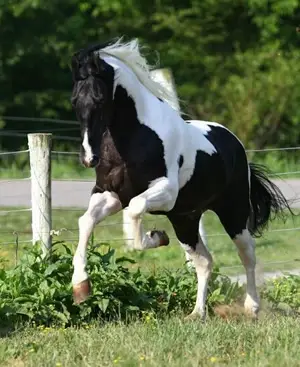General Description
The formation and development of the Spotted Saddle Horse Association was a natural response to the rapid growth of the breed. The SSHBEA (Sheeba), a nonprofit, state-charted organization, was established in the fall of 1985 by persons interested in preserving the gait and color of this animal. Operating out of Shelbyville, Tennessee the SSHBEA maintains a registry, develops the rules and regulations governing all aspects of the breed, licensed judges and affiliates shows.
As the official registry of the breed, the SSHBEA records and maintains pedigrees, ownership, transfers, and color information. The SSHBEA keeps list of stallions as well as get, produce and show records. A governing board of five officers and Board of Directors are elected to direct the functions of the breed.
A Spotted Saddle Horse is a light horse type used mainly for pleasure, utility and show purposes. Its breeding is based upon the bloodline of foundation stock and horses registered in the Spotted Saddle Horse Breeders' and Exhibitors Association. A desirable type in a saddle horse requires a horse of medium size and weight, generally ranging in height from 14.3 to 16 hands and weighing from 900 to 1100 pounds. This horse has a long sloping hip and shoulder, a fairly short back and a short strong coupling. The bottom line is longer than the top line, allowing a long stride. A Spotted Saddle Horse must posses a white marking above its hocks, other than facial, and must perform a smooth, easy, non-trotting gait to be eligible for registration.
The Spotted Saddle Horse is most easily recognized by its colorful coat. A wide variety of acceptable colors and patterns make each horse unique unto itself. The spectrum of colors range from almost solid color to almost solid white in the two main color patterns, overo and tobiano, and encompasses all of the hues known in the horse world.
Gaits
The Spotted Saddle Horse performs the show walk, show gait and canter. These three are the gaits for which this breed is famous, with the show gait being an inherited naturally smooth gait unique to this breed. The Spotted Saddle horse is also able to perform the rack, stepping pace, fox-trot, single-foot and other variation s of the intermediate gait.
The flat walk is a brisk, long-reaching walk that can cover 4 to 8 miles an hour. This is a four cornered gait with each of the horse's feet hitting the ground separately at regular intervals.
The show gait is the intermediate gait for the Spotted Saddle Horse. This extra-smooth gliding gait is basically the same as the flat walk with a marked increase in speed. This breed can travel at 10 to 20 miles per hour at this gait. This give the rider a feeling as if he or she were gliding through the air propelled by some powerful but smooth-running machine.
The canter is a forward movement performed in a diagonal manner to the right or to the left. On the right lead, the horse should start the gait in this order: left hind, right hind and left for together - then right fore. The order for the lead is right hind, left hind and right fore, then left fore. When performed in a ring, the animal should lead his canter with the fore leg to the inside of the ring. This is often referred to as the "rocking-chair-gait."






